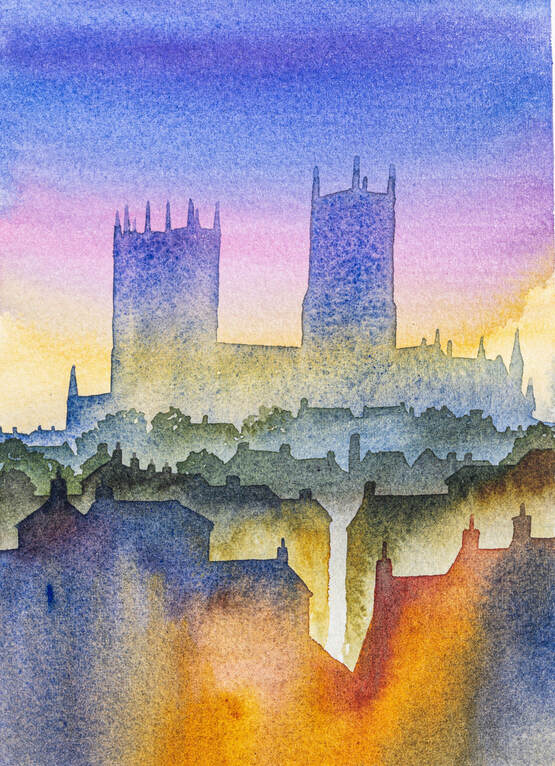Lincoln by Ian Scott Massie
Original Watercolour
12" x 10" Mounted size - 7.5" x 5.5" Image size
Available: unframed @ £215
To shop, please click here
12" x 10" Mounted size - 7.5" x 5.5" Image size
Available: unframed @ £215
To shop, please click here
LINCOLN
Lincolnshire is well known for being mostly flat. In the Fens dykes and channels, ruler-straight, run to the wide horizon. The sweep of wind from the sea is a constant presence. Surprisingly then, Lincoln is a city on a hill, the cathedral lifted high against the clouds. Seen from any direction it creates a sense of wonder.
The approach to the cathedral I like best is up Steep Hill (known locally as “Heart Attack Alley”). At the top is a broad cobbled space surrounded by a group of venerable buildings. To the left lies Lincoln Castle, its high medieval wall enclosing a Victorian prison. Ahead stands the half timbered Leigh Pemberton House and to the right, behind the broad Exchequer Gate, rises the gothic masterpiece of Lincoln Cathedral.
For three hundred years this was the tallest building in the world. It had three slender spires and when they fell, so did the title. This building is the largest cathedral in England after St Pauls and York. Inside the absence of pews engenders a sense of openness and calm.
Standing in the vast space, lit by shafts of coloured light from the stained glass, the cathedral has a warm, welcoming feel. It has everything a good cathedral should plus a side order of quirkiness. The vaulted roof above the choir is strangely asymmetrical, the choir stalls are decorated with a host of bizarre carvings and, high up in the angel choir, is the famous Lincoln Imp - a small malicious servant of Satan turned to stone by an angel.
Like many cathedrals Lincoln also has a sad story. Little St Hugh was a nine year old who, in 1255, was found dead in a well. Following a malicious antisemitic rumour the jews of Lincoln were accused of his murder. By order of Henry III ninety jews were arrested and eighteen executed. In the wake of this episode Hugh’s shrine drew huge crowds to the cathedral and money to its treasury. The remains of his shrine still stand in the south choir aisle, a reminder of a shameful period of English history.
The approach to the cathedral I like best is up Steep Hill (known locally as “Heart Attack Alley”). At the top is a broad cobbled space surrounded by a group of venerable buildings. To the left lies Lincoln Castle, its high medieval wall enclosing a Victorian prison. Ahead stands the half timbered Leigh Pemberton House and to the right, behind the broad Exchequer Gate, rises the gothic masterpiece of Lincoln Cathedral.
For three hundred years this was the tallest building in the world. It had three slender spires and when they fell, so did the title. This building is the largest cathedral in England after St Pauls and York. Inside the absence of pews engenders a sense of openness and calm.
Standing in the vast space, lit by shafts of coloured light from the stained glass, the cathedral has a warm, welcoming feel. It has everything a good cathedral should plus a side order of quirkiness. The vaulted roof above the choir is strangely asymmetrical, the choir stalls are decorated with a host of bizarre carvings and, high up in the angel choir, is the famous Lincoln Imp - a small malicious servant of Satan turned to stone by an angel.
Like many cathedrals Lincoln also has a sad story. Little St Hugh was a nine year old who, in 1255, was found dead in a well. Following a malicious antisemitic rumour the jews of Lincoln were accused of his murder. By order of Henry III ninety jews were arrested and eighteen executed. In the wake of this episode Hugh’s shrine drew huge crowds to the cathedral and money to its treasury. The remains of his shrine still stand in the south choir aisle, a reminder of a shameful period of English history.





